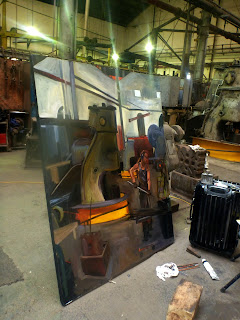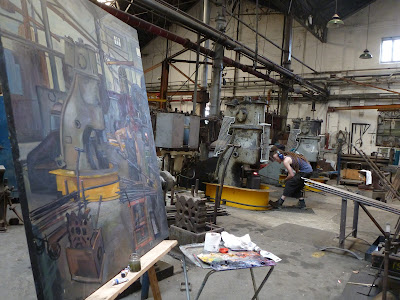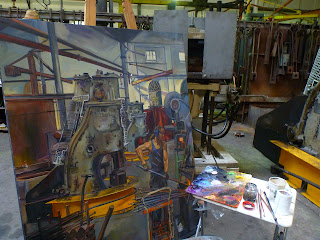Sydney is to me, not the emerald city or the Harbour city, but a golden city - the sandstone city. Sandstone seems to be everywhere -from sand and rocks on the beaches to the glorious escarpments revealed by cuttings for expressways. But most of this apparent abundance is commercially useless and the rest is fit only for fill or crazy paving at best.
The only sandstone of sufficient quality and durability to be used to restore or replace the exquisite carvings of Sydney's iconic 19th century architectural heritage such as the Queen Victoria building, the buildings on Macquarie St, or the University of Sydney is Pyrmont yellowblock.
Sandstone is a sedimentary rock consisting mostly of quartz or a mix of quartz and feldspar sands, in conjunction with materials such as calcite, clay, iron oxides, and silica which cement it together. It takes on the color of its components, most commonly tan to yellowish or tinted pink to dark red due to varying levels of iron oxide.
There are a lot of variations of texture and color, not many of which are suitable for commercial use. Common forms of sandstone include arkose which has a high feldspar content, graywacke which contains angular rock fragments, and conglomerate which contains rounded rock fragments. Other common stones included in this category are bluestone- a hard, dense feldspathic sandstone; brownstone- a reddish-brown stone taking its color from its high iron content;and flagstone- a sandstone or sandy slate that is easily split into large, thin slabs.
The spine of the Pyrmont peninsula is a sandstone ridge, still visible at Pyrmont Point despite reshaping by deforestation, quarrying, land reclamation and subsequent industrialization and de-industrialization. Pyrmont's topography was dramatically altered as the quarrymasters cut vast swathes through its famous yellowblock, stripping it bare to make the rest of Sydney beautiful.

" Ways Terrace, Pyrmont"
1994 oil on board 41 x 122cm
Enquiries
Often the demolition madness that engulfed the peninsula throughout the 1990s would have the unexpected bonus of revealing the hidden beauty beneath the surface.
In 1989 the gardens planted by local residents in the James Watkinson Reserve in front of Ways Terrace were demolished and left derelict. The 2 dead trees on the hill were a notorious landmark for over a decade. The hole became a pond with many waterfowl, so possibly it was the site of the original Pyrmont spring.
When LendLease started the demolition of the CSR Distillery for the Jackson's Landing development, McCaffery's stables were excavated and revived as a premium source of sandstone.
It was cut like giant blocks of cheese and stored under the newly built Anzac Bridge before being sculpted to restore heritage projects on historic buildings all over Sydney.
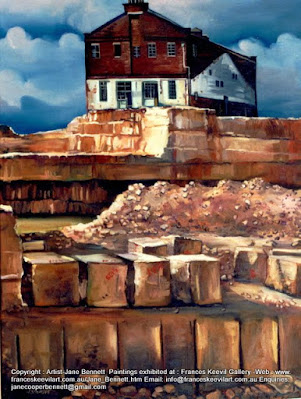
"Pyrmont - McCaffery's Hill -Demolition of CSR Distillery "
2000 oil on canvas 61 x 46 cm
Enquiries
This painting shows the site of the old "Paradise Quarry" , renowned as the source of the best Pyrmont yellowblock sandstone during the 19th century.
The "paradise stone" was a warm honey-yellow to brown colour but was dense fine-grained and comparatively difficult to work compared to the stone from the other 2 quarries, "Purgatory" and "Hellhole".
After the quarries closed in the late 19th century, the McCaffrey's stables were built there by the CSR to stable the horses that transported the sugar and rum from the refinery and distillery. Later the stables were used to house the brilliant green sugar trucks which had replaced the horses and carts.

" Sandstone under the Anzac Bridge" 1998
oil on canvas 41 x 61cm
Enquiries
After these blocks of sandstone had been quarried at McCaffrey's Stables, they were then sent to cool their heels for a while under the Anzac Bridge, where the dragon boats are now stored.
Later these blocks were sent to the stone masons trained by the master mason George Proudman under the Centenary Stoneworks Programme. Eventually this sandstone was used to restore heritage items such as the gargoyles of the University of Sydney.
Pyrmont’s sandstone has decorated the best loved historic Sydney buildings such as the Australian Museum, the Sydney Post Office, the Lands Department and the University of Sydney. These intricate swirls of foliage writhe around the top of the columns of the western entrance of Sydney Technical College in Ultimo.

P258 'Capital of Sydney Technical College'
2012 oil on canvas 20 x 20cm
The Sydney Technical College building, which is part of the main campus of Sydney Institute of TAFE (Technical and Further Education), is on Mary Ann Street at the southern end of Bulwara Road in Ultimo, although the street address is given as 651-731 Harris Street. Built in 1891, it was designed by William Kemp in the Federation Romanesque architectural style. I call it Glebe Gothic.

P259 'Capital of Sydney Technical College' 2012
oil on canvas 20 x 20cm
Enquiries
The heavily ornate brick and terracocotta construction is adorned with bizarrely incongruous Australian ornamental plants and animals such as waratahs, kangaroos, wombats, echidnas, platypuses and lizards.
They were created by the master sculptor of the Lands Department building, William Priestly Macintosh.
There is a similar outburst of patriotism with the sculptors of the gargoyles and grotesques of the University of Sydney. Some Australian fauna can be adapted into truly frightening gargoyles and it's a pity that their forms were unknown to the master craftsmen of Cluny. One of the bug-eyed twitchy kangaroos with bared claws poised to hurtle off the roof of the Quadrangle is known fondly by the students as "Skippy on a 3 day meth binge".

'The Lizards of oz-
Sydney Technical College, Ultimo Tafe' 2012
oil on board 20 x 40cm
Enquiries
Lizards do enjoy soaking up the warmth, and the golden sandstone attracts the few feeble rays of sun that have been available this wet summer.
These goannas have picked a precarious but attractive perch to catch up on their tans while stalking the hapless marsupials and monotremes that cling to the arches below. The platypus seems unaware but the possum looks very alarmed and turns to hiss in anger.
The sculptor has done a wonderful job of reproducing the scaliness of their skins, and even the slight greying discolouration of the sandstone on their backs helps add to the illusion of reptilian flesh.
Related posts
To the Point
Wrong side of the tracks - Darling Island Bond and Free
Pretty vacant
My Pyrmont page in this blog
Pyrmont Paintings past and present
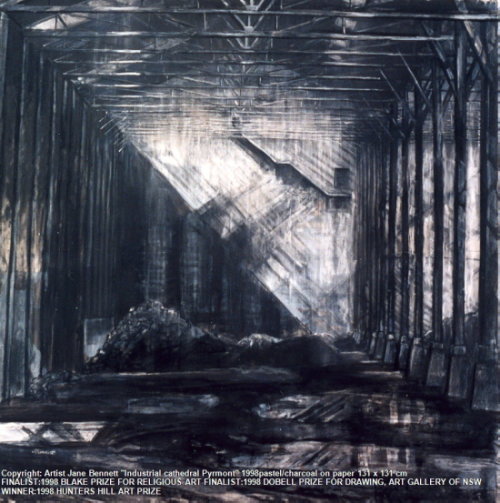





.JPG)
.JPG)



.JPG)

